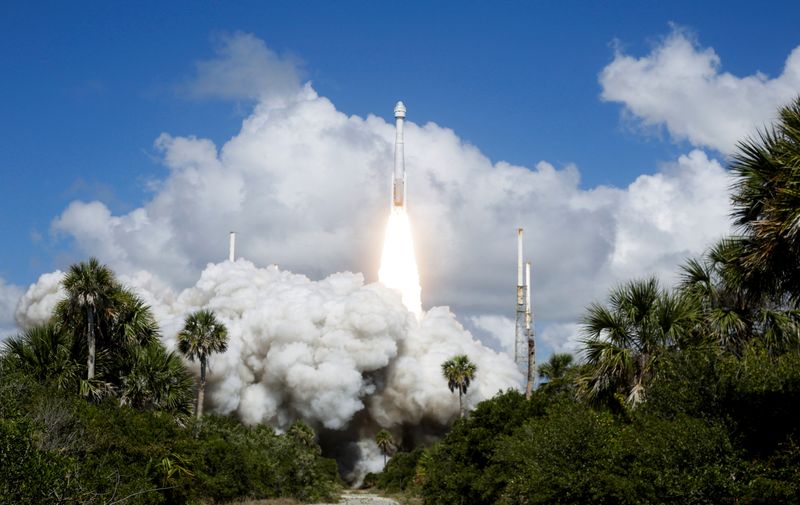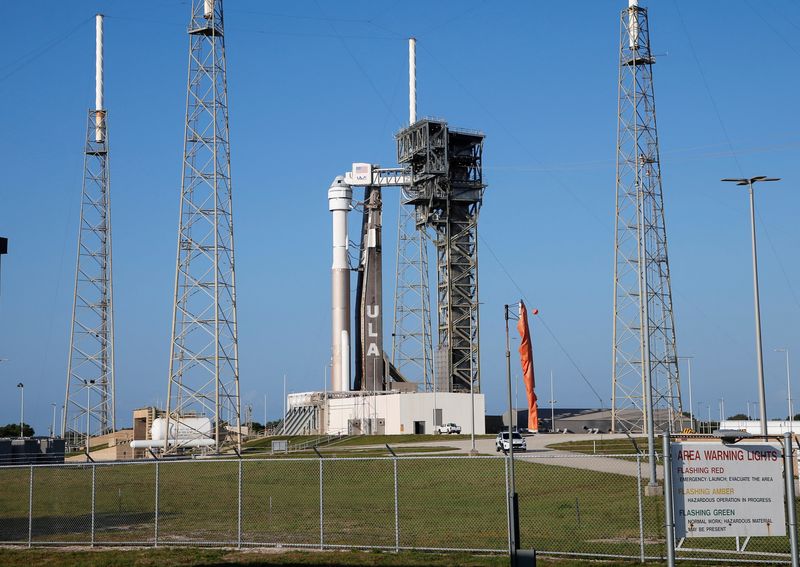By Joey Roulette
CAPE CANAVERAL, Florida (Reuters) -Boeing's new Starliner capsule flew its first crew of astronauts to orbit on Wednesday from Florida in a much-delayed test mission to the International Space Station, a milestone in the aerospace giant's ambitions to step up its competition with Elon Musk's SpaceX.
The CST-100 Starliner, with astronauts Barry "Butch" Wilmore and Sunita "Suni" Williams aboard, lifted off from the Cape Canaveral Space Force Station, strapped to an Atlas (NYSE:ATCO) V rocket furnished and flown by the Boeing-Lockheed Martin joint venture United Launch Alliance (ULA).
The gumdrop-shaped capsule and its crew are headed for a rendezvous with the International Space Station (ISS) following years of technical problems, delays and a successful 2022 test mission to the orbital laboratory without astronauts aboard.
The rocket's engines thundered to life in flaming clouds of exhaust and coolant-water vapor as the spacecraft roared off its launch pad into sunny skies from Florida's Atlantic Coast.
The rocket's upper stage separated from its core booster about four minutes into flight, followed by Starliner's separation from the second stage. On its own, the spacecraft fired onboard thrusters to push itself into orbit, kicking off its 24-hour catch-up journey with the ISS, which orbits some 250 miles (400 km) above Earth.
Boeing (NYSE:BA) intends for Starliner - seeded with NASA funding - to compete with SpaceX's Crew Dragon capsule, which since 2020 has been the U.S. space agency's only vehicle for sending ISS crew members to orbit from U.S. soil.
"This is another milestone in this extraordinary history of NASA," the agency's administrator Bill Nelson told a press conference.
The mission is a test flight required before NASA can certify Starliner for routine astronaut missions. Now in space, the capsule will need to execute precise maneuvers to dock with the ISS on Thursday, demonstrate it can stay docked for about eight days, then safely return the two astronauts to Earth, among other flight objectives.
Mark Nappi, Boeing's Starliner program chief, told reporters that tens of thousands of things have to go right during Starliner's launch, and that on Wednesday "it all lined up."
"We had just a perfect countdown and launch. ... It's been a long time coming. And we're really, really proud," Nappi said.
Boeing shares closed up 0.7%.
Last-minute issues had nixed the Starliner's first two crewed launch attempts. A May 6 countdown was halted two hours before liftoff over three issues that required weeks of extra scrutiny. Another try last Saturday was halted less than four minutes before liftoff because of a launchpad computer glitch.
The seven-seat Starliner's inaugural crew includes two veteran NASA astronauts in Wilmore, 61, a retired U.S. Navy captain and fighter pilot, and Williams, 58, a former Navy helicopter test pilot with experience flying more than 30 different aircraft.
They have spent a combined 500 days in space over the course of two ISS missions each. Wilmore is the designated commander, with Williams in the pilot seat.
BOEING AMBITIONS
Boeing, with its commercial airplane operations rocked by a series of crises involving its 737 MAX jetliners, needs a win in space for its Starliner venture, already several years behind schedule and more than $1.5 billion over budget. Getting Starliner to this point has been a fraught process for Boeing under its $4.2 billion fixed-priced contract with NASA, which wants the redundancy of two different U.S. rides to the ISS.
The longtime NASA contractor has built modules for the decades-old ISS and rockets designed to loft astronauts toward the moon. But Boeing never before built its own operational spacecraft, a feat complicated by years of software issues, technical glitches and management shakeups on the Starliner program.
SpaceX's Crew Dragon has become a dependable taxi to orbit for NASA. That capsule and Starliner are among the first in a new generation of privately built spacecraft designed to fly astronauts to low-Earth orbit, and later to the moon under NASA's Artemis program.
Starliner, which like Crew Dragon is reusable, would compete head-to-head with the SpaceX capsule, which since 2020 has been NASA's only vehicle for sending ISS crew members to orbit from U.S. soil.
"Congratulations on a successful launch," Musk wrote on social media.
Boeing intends to build two Starliner capsules that can carry out NASA astronaut missions, and possibly more for private spaceflight missions, depending on commercial demand, Nappi said.

That demand is driven by government space agencies and early plans from other companies, such as Jeff Bezos' Blue Origin, to build privately run space stations whose development NASA is funding to replace the aging ISS in 2030. Crew Dragon has flown nine NASA astronaut missions to the ISS and four private customer missions.
Wilmore and Williams are due to join ISS's current seven resident crew members before riding Starliner back to Earth for a parachute and airbag-assisted landing in the U.S. Desert Southwest - a first for a crewed NASA mission.
